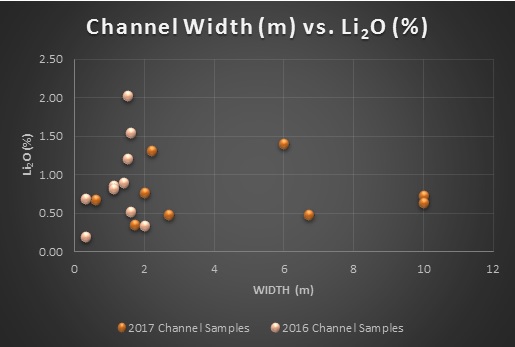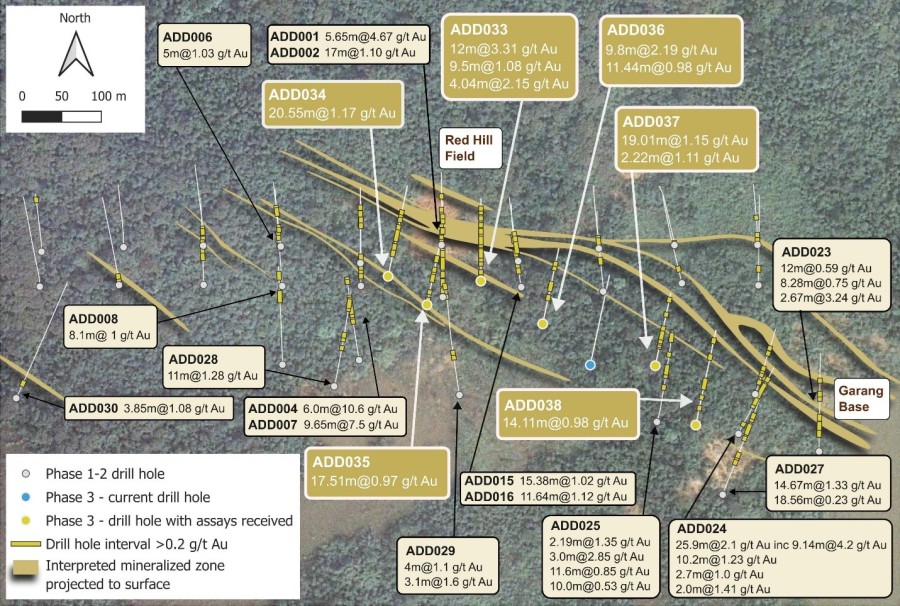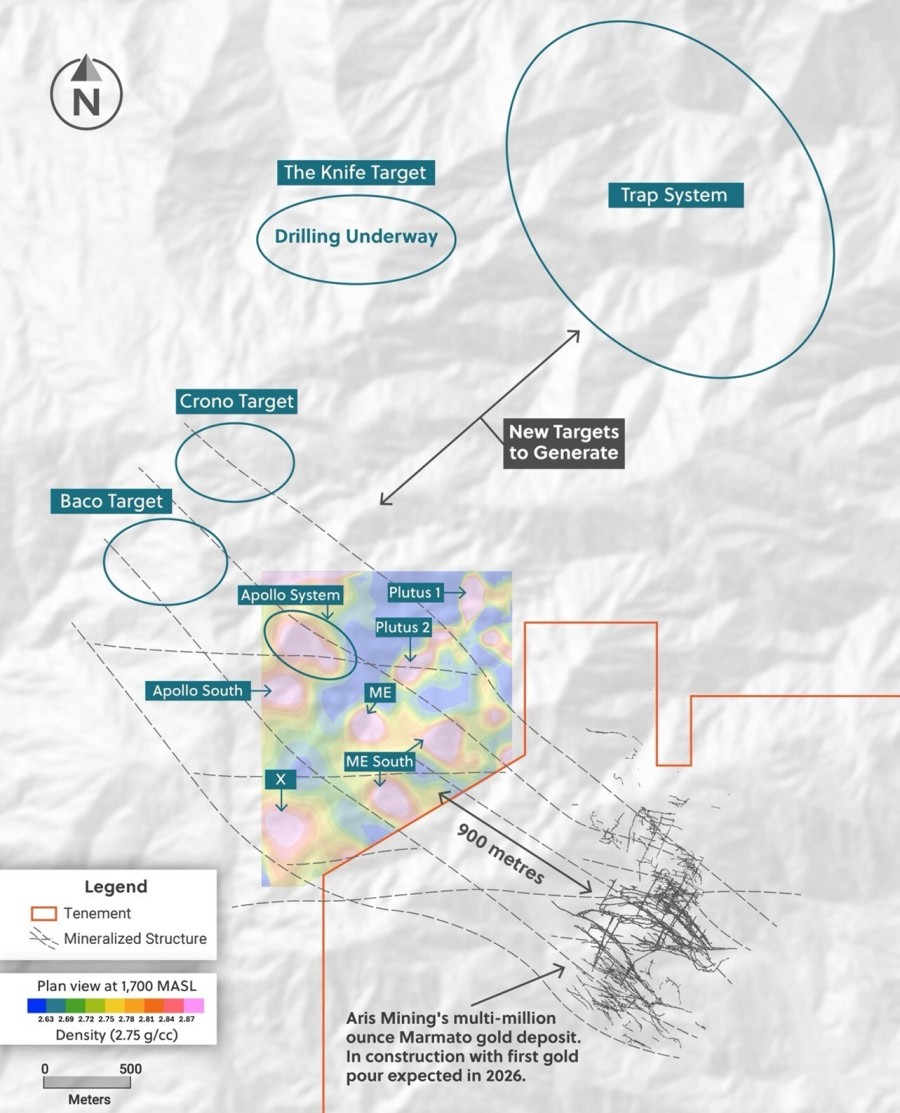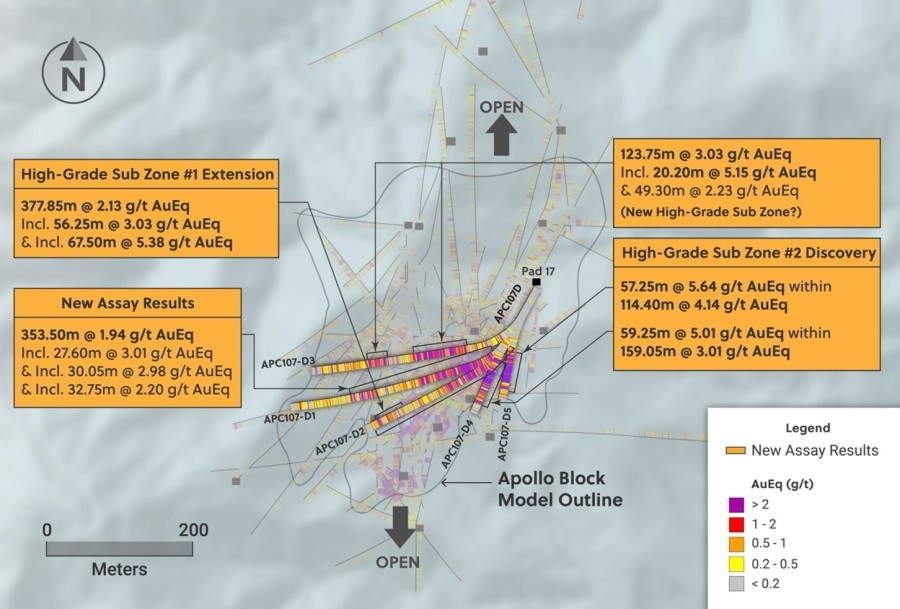VANCOUVER, British Columbia, Sept. 13, 2017 (GLOBE NEWSWIRE) -- Centenera Mining Corporation (“Centenera” or the “Company”) - (TSX-V:CT) (OTCQB:CTMIF), reports that it has received positive results from surface samplings at the El Quemado Lithium Pegmatite Project (the “El Quemado Project”), solidifying the Santa Elena target ("Santa Elena") as the top priority going forward. Santa Elena has returned multiple anomalous channel samples (see Table 1 and Figure 1 & Figure 2 below) demonstrating that the lithium mineralization is extensive in the outcropping pegmatite dikes. In addition, the orientation soil sampling results are interpreted by the Company as demonstrating that lithium bearing pegmatites likely continue under soil cover to the north and the south of Santa Elena. The Company intends to continue with additional soil sampling to establish the total potential strike length of the mineralized pegmatites.
Figure 1. Compilation of all surface sampling results at the Santa Elena target area, including rock chip samples, channel samples and orientation soil samples. Channel samples labelled with sample numbers are described in Table 1 with both grade and sample width. Note that the central claim is not held under option by the Company.
Figure 2. Plot of rock sample grade versus sample length at Santa Elena target area.
Figure 3. Map of the Las Pailas target area showing limited sampling and extensive areas of interpreted outcropping pegmatite, which has yet to be systematically sampled.
Santa Elena Rock Sampling Results
Outcropping pegmatites were sampled by standard rock chip samples and channel samples taken using a mechanical rock saw to cut a channel across the pegmatites. All samples were taken perpendicular to the strike of the pegmatite veins and, as such, closely approximate their true width. Channel samples are more time consuming and expensive to obtain, but result in superior quality samples as they remove subjectivity from the sampling process. Highlights of the channel sampling results are included in Table 1 below.
| Table 1. Highlights of Rock Channel Sampling at Santa Elena Target. | ||
| Channel ID | Length (m) | Li2O (%)* |
| ElQ-0013 | 6 | 1.41 |
| ElQ-14B | 2.2 | 1.32 |
| ElQ-14C | 2 | 0.77 |
| ElQ-0007 | 10 | 0.73 |
| ElQ-0012 | 0.6 | 0.68 |
| ElQ-0006 | 10 | 0.64 |
| ElQ-0071 | 6.7 | 0.49 |
| ElQ-0010 | 2.7 | 0.48 |
| ElQ-0008 | 1.7 | 0.36 |
*Li2O % values calculated using (Li ppm/10,000) x 2.153
Orientation soil samples were taken northwest and southeast of the outcropping pegmatite dikes. The purpose of the orientation survey was to investigate whether soil sampling could be used to detect lithium mineralized pegmatites under soil cover.
At Santa Elena, lithium was detected in soils directly along strike from mineralized outcrops (Figure 1), suggesting that mineralized pegmatites at Santa Elena can be detected using soil sampling. These initial results provide the Company with a cost-effective tool with which to evaluate the remainder of the target area. It is likely that systematic soil sampling will allow pegmatite mineralization to be traced under soil cover generating targets that can be tested by trenching or drilling as appropriate. It should be possible to establish a total expected strike length and, potentially, the number of pegmatite dikes, before trenching or drill testing commences.
Rock Sampling at Other El Quemado Project Targets
Sampling at the Las Pailas target was severely curtailed by bad weather which resulted in the exploration work being abandoned. As a result, only 11 channel samples from approximately 75 planned channel samples were taken (Figure 3). No anomalous lithium was identified in the samples taken, but field reports indicate that the lithium mineral spodumene was identified in outcrop. As a result, the Las Pailas target area remains a high priority for future work.
Potential pegmatite dikes at the El Penon target were field checked and identified as un-mineralized dacite porphyry dikes of no further interest. Pegmatite dikes were located at the Tres Cumbres target, but sampling did not locate anomalous lithium mineralization and no future work is planned for this target area.
No sampling was undertaken at the Leilita target, located at the far north end of the El Quemado Project. This target remains open for future exploration.
About Lithium
Lithium is produced from both brines and hard-rock sources (pegmatites). Estimates from 2015 suggest that global lithium production from conventional hard-rock mining of lithium minerals may be as high as 44% (source: Macquarie research 2016). Lithium pegmatites are a viable source of the metal due to their high concentration in ores relative to brines. Production from these lithium pegmatite deposits mitigates global concerns regarding undue dependence on supplies from dominant brine producers in Chile and Argentina. As a grade comparison, moderate to high brine grades of 400ppm lithium equate to 0.04% lithium, whereas initial sampling at the El Quemado Project has returned grades as high as 9,400ppm or 0.94% lithium. Chemical-grade lithium refers to spodumene that is converted to lithium carbonate or lithium hydroxide. Pegmatites are a source of technical-grade lithium, where spodumene is used directly in the ceramics or glass industries without processing.
About Pegmatites
Pegmatites are igneous rocks that form during the final stage of a cooling magma's crystallization. To be called a pegmatite, a rock should be composed almost entirely of crystals that are at least one centimeter in diameter. Most pegmatites have a composition that is similar to granite with an abundance of quartz, feldspar and mica. Pegmatites can be sources of valuable minerals such as spodumene (a lithium-bearing mineral) that are rarely found in economic amounts in other types of rocks. In the initial stages of crystallization, the ions that form high-temperature minerals are depleted from the melt. Rare ions that do not participate in the crystallization of common rock-forming minerals become concentrated in the melt and in the excluded water. These ions can form the rare minerals that are often found in pegmatites. Examples include small ions such as lithium and beryllium that form spodumene or large ions such as tantalum that form tantalite. Rare elements concentrated in large crystals make pegmatite a potential source of economic concentrations.
Quality Assurance / Quality Control
Quality assurance and quality control procedures include the systematic insertion of blanks, standards and duplicates into the channel, rock and soil sample sequences. The results of the control samples are evaluated and results are re-analysed and/or resubmitted as needed. All results stated in this news release have passed the Company’s quality assurance and quality control protocols.
Channel samples were taken using a gas-powered rock saw with a diamond tipped saw blade to cut a channel across the outcropping pegmatite dikes. The rock saw was used to prepare a channel approximately 5 cm in width and depth, the rock was then broken out from the channel using a hammer and chisel. All rock samples were accompanied by a hand specimen, identified with the number of the sample for later petrographic work if warranted. All samples were collected and catalogued under the supervision of Company geologists in accordance with standard industry practice. Samples were dispatched to the SGS laboratory in Callao, Peru, an ISO 9001:2000 accredited laboratory, for digestion using sodium peroxide fusion method and analysis using inductively coupled plasma atomic emission spectroscopy.
Qualified Person
Tyler Caswell, P.Geo., the Company's Exploration Manager and a qualified person as defined by National Instrument 43-101, has reviewed the scientific and technical information that forms the basis for portions of this news release, and has approved the disclosure herein. Mr. Caswell is not independent of the Company, as he is an employee and holds incentive stock options.
About Centenera Mining Corporation
Centenera is a mineral resource company trading on the TSX Venture Exchange, under the symbol "CT" and on the OTCQB exchange under the symbol "CTMIF". The Company is focused 100% on prospects in Argentina. The Company intends to focus its 2017 exploration activities on drill-testing its flagship Huachi copper-gold project. The Company has made application for a drilling permit through the underlying owner and is awaiting approval to begin exploration. Other assets, such as the El Quemado lithium pegmatite project in Salta Province are intended with be explored by the Company with the aim of proving project potential and attracting a joint venture partner or a project sale. The Company also intends to seek a joint venture partner for its Organullo gold project, which has approximately 8,000 meters of historical drilling and assay results. The Organullo project has a geological target range from 19.8 million tonnes grading at 0.94 g/t gold (600,000 ounces) to 31.6 million tonnes grading 0.92 g/t gold (940,000 ounces) using a 0.5 g/t gold cut-off-grade. It should be noted that these potential exploration target quantities and grades are conceptual in nature, that insufficient exploration and geological modelling has been done to define a mineral resource, and that it is uncertain if further exploration will result in the delineation of a mineral resource.





